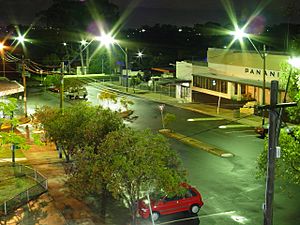Panania facts for kids
Quick facts for kids PananiaSydney, New South Wales |
|||||||||||||||
|---|---|---|---|---|---|---|---|---|---|---|---|---|---|---|---|

Shops and post office in Panania (Catalan) 2007
|
|||||||||||||||
| Population | 11,489 (2011 census) | ||||||||||||||
| Postcode(s) | 2213 | ||||||||||||||
| Elevation | 23 m (75 ft) | ||||||||||||||
| Location | 23 km (14 mi) south-west of Sydney CBD | ||||||||||||||
| LGA(s) | City of Canterbury-Bankstown | ||||||||||||||
| State electorate(s) | East Hills | ||||||||||||||
| Federal Division(s) | Banks | ||||||||||||||
|
|||||||||||||||
Panania is a suburb located in Sydney, New South Wales, Australia. It's about 23 kilometres southwest of the main city centre. Panania is part of the City of Canterbury-Bankstown area. Its postcode is 2213, which it shares with nearby suburbs like East Hills and Picnic Point.
To the north, Panania is bordered by the M5 South Western Motorway and the suburb of Milperra. To the south, you'll find Picnic Point, which has lovely parklands along the Georges River. East Hills is to the west, and Revesby is to the east.
Contents
Panania's Past
The name Panania was first suggested for a train station way back in 1929. Before that, this area was just known as part of the East Hills district. The word Panania comes from an Aboriginal language. It means sun rising in the east and shining on the hills. Another idea is that the name might come from "Pannonia", an old Roman province. While the railway was being built, the station was called Nioka, which is another Aboriginal word meaning the green hill.
The arrival of the railway in 1931 really helped the East Hills area grow. Before the trains, this district was mostly farmland. There was a special settlement for soldiers who had returned from war in Milperra. They mostly raised chickens and grew plants. Getting to the Sydney city centre for work was hard because the only public transport was a bus to Bankstown railway station.
After World War II, Panania grew very quickly. The Australian Legion of Ex-Servicemen and Women helped build many houses in Panania starting in 1946.
St Christopher's Catholic Church on Tower Street used to be a cinema called the Panania Star. Panania North Public School, which is just a short walk north of the railway line, became a special "demonstration school" in the late 1970s. This meant that new teachers from the nearby Milperra College could watch experienced teachers at work there.
Shopping and Local Life
Panania has a busy shopping area right next to Panania railway station. You can find shops along Weston Street, Anderson Avenue, and Tower Street. Anderson Avenue also has local facilities like a centre for senior citizens and a public library. The Panania Hotel is located on the northern side of the railway station.
The local Business Chamber is very active and helps make Panania a strong community.
Getting Around Panania
Panania railway station is on the East Hills railway line. This train line used to end one stop away at East Hills. But in the 1980s, the line was extended with a train bridge over the Georges River all the way to Campbelltown.
Some parts of Panania are also served by buses run by U-Go Mobility. These bus routes generally follow the paths that were set up by McVicar's Bus Services a long time ago.
Who Lives in Panania?
In 2011, Panania had a population of 11,489 people. Slightly more than half (51.4%) were female, and 48.6% were male. Most people (72.8%) were born in Australia. About 1.4% of the population were Indigenous Australians.
In 2006, about 45.6% of the people living in Panania had jobs.
When it comes to religion in 2011, the most common beliefs were: Catholic (32.2%), Anglican (20.7%), and No Religion (11.0%). Other religions included Eastern Orthodox (8.0%) and Islam (5.1%).
Churches in Panania
Panania has several important churches. These include Holy Trinity Anglican Church and St Christopher's Catholic Church. St Christopher's is in a building that used to be the Panania Star Cinema. This cinema was built in 1952 in the Art Deco style, which is a cool design from that time. The building still has some of its original features, like a fancy ceiling. After getting money from the Roman Catholic Archdiocese of Sydney and many donations, the building was renovated in 2006.
The Salvation Army also has a church, called a Corps, in Panania. Their old building was recently updated.
Panania Uniting Church started in the early 1950s. It moved to its current spot at 206 Marco Ave, Panania, in 1967.
Schools in Panania
- East Hills Girls Technology High School
- East Hills Boys High School (started in 1955)
- Panania Public School
- Panania North Public School
- Tower Street Public School
- St Christopher's Catholic School
Homes in Panania
Panania is mostly a place where people live. It grew a lot after World War II. Back then, many homes were small, simple bungalows made from a material called asbestos cement sheeting, often called "fibro". Today, many of these older houses have been replaced with bigger, newer homes or two-storey duplexes.
Famous People from Panania
Many well-known people have lived in Panania, including:
- Paul Abrahams, who played bass for the band The Reels
- Actor Bryan Brown
- Col Joye, a singer-songwriter
- Paul Makin, a journalist
- Ron Raper, a rugby league player
- Andrew and Michael Tierney from the band Human Nature
- Steve Waugh and Mark Waugh, famous Australian cricketers
Images for kids





